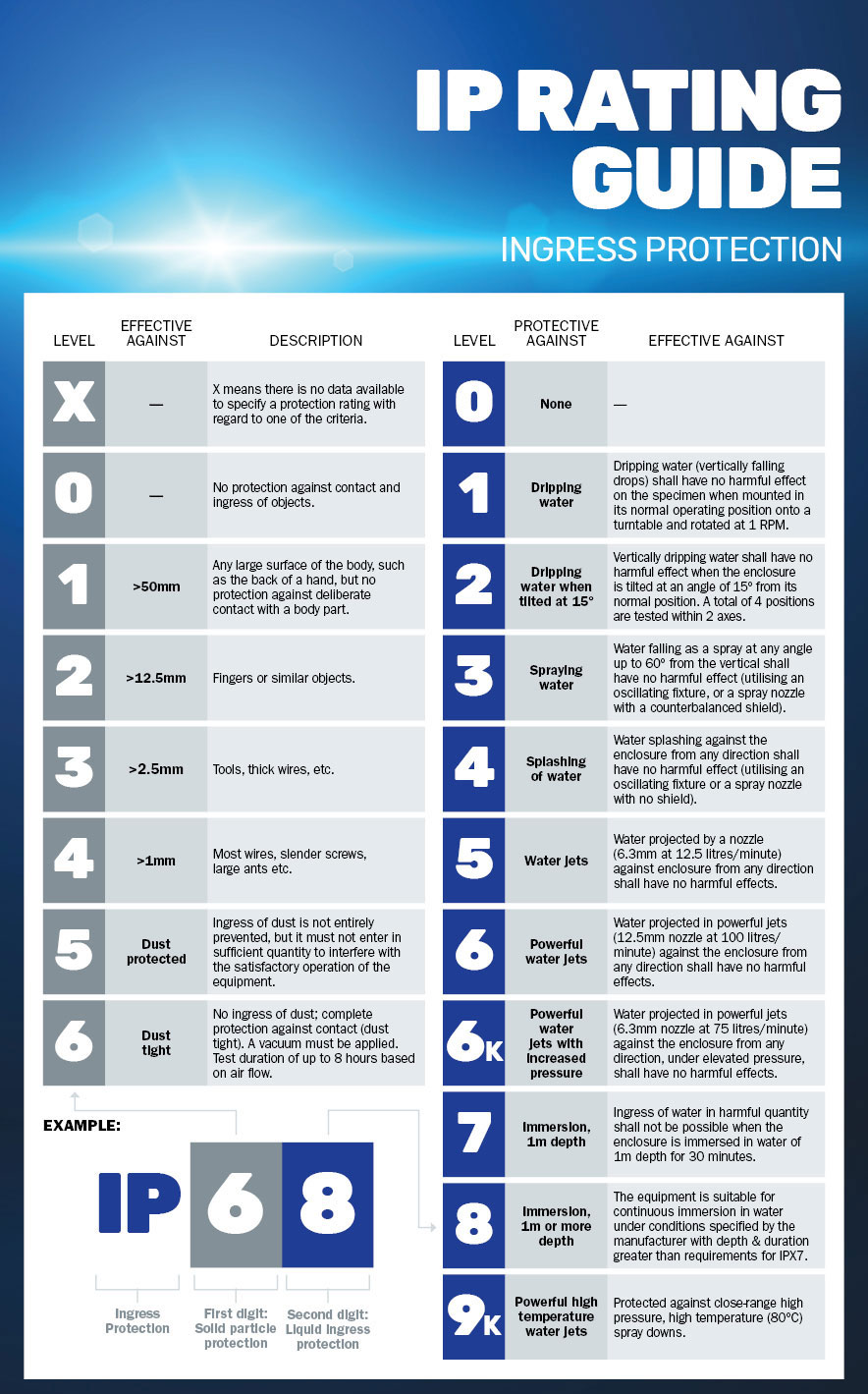What is an IP rating? Everything You Need to Know About IP Ratings in Lighting
When you are out shopping for new lighting, you might notice a two-digit number stating the IP rating. But, what does that number even mean?
Here, we are talking all about IP ratings in lighting and why they matter. Let’s get started!
What is an IP Rating?
The IP Rating (or, Ingress Protection Rating) of your light fitting is an international standard. It refers to how protected your lighting is to objects or water penetrating the fitting itself.
Essentially, it’s about how well-protected your lighting product will be from external influences.
You will find IP Ratings on all kinds of lighting, including ceiling fans and it tells you what exactly your light fitting is protected from.
The first number in an IP Rating, from 0 to 6, refers to how effective it is at protecting against objects based on its size. This matters for external objects like wires, fingers, and screws.
The second number refers to how protective the fitting is against water damage based on volume, ranging from 0 to 9.
For example, if the first number in your IP Rating is 1, it means your lighting is protected from large body parts. But if the first number is a 6, it’s protected from objects as small as dust particles.
Then, if the second number in your IP Rating is a 1, your fitting is protected from dripping water. But at an 8, it’s protected from water immersion of up to one metre.
In short, the higher each digit in an IP Rating, the more protected your lighting will be.

Why do IP Ratings matter?
So, why do these ratings matter? Well, you will need to meet certain regulations (based on where you live) that ensures your lighting has a specific IP Rating depending on where it’ll be installed.
Basically, you won’t want to install lighting with a low IP Rating in a bathroom where there’s a constant threat of water penetration. However, in other rooms of your home, lighting with a lower IP Rating will generally suffice.
In general, it’s always smart to speak with a lighting professional to ensure you are purchasing the best fitting for every space in your home, but here are a few tips.
Outdoor Lighting
Whether you have garden lighting, lighting for your outdoor dining room, security lighting, or path lighting leading to your front door, you will want a high IP Rating to protect your outdoor light fittings from water damage and exposure to the elements.
A rating of IP65 is recommended for any outdoor lighting where it is fully exposed, alternatively a rating of IP54 is suitable if fitted under an eave.
Kitchen Lighting
Similar to light fittings in your bathroom, kitchen lighting is prone to external influences and water than other rooms in your home. Especially near the sink and cooktop, you’ll want an IP Rating of at least IP44.
Bathroom Lighting
Lighting your bathroom can be tricky as there’s a lot going on in these tight spaces.
We get that it’s a little overwhelming, to say the least. So, to make things a bit more manageable, bathroom zoning can be a huge help when it comes to installing lighting that meets proper IP Rating requirements.

Let’s go over these bathroom zones and the minimum IP Rating recommended for each.
Zone 0 refers to the bottom inside section of a bath or shower and requires low voltage (max 12v) lighting with an IP Rating of at least IP67. It requires such a high rating because this zone will constantly get completely submerged in water. Lighting isn’t often placed in these zones, but if you want to get fancy with your bathroom decor, it can add a lot of finesse to your space.
Zone 1 includes the walls of your shower or bathtub. It’s still likely to get soaking wet but won’t necessarily be totally submerged in water. So, lighting in these areas only need to have an IP Rating of IP44. However, like in Zone 0, a rating of IP65 is still recommended.
Try our recessed downlights with an IP65 rating in Zone 1.
Zone 2 refers to any area that’s 0.6m or more away from the edges of your shower or bath. These spots might get a few splashes coming their way here and there. But, this zone will be a lot less wet in the grand scheme of things. A rating of IP44 is required for Zone 2 but, to be on the safe side, IP65 lighting could still be your best bet here, especially around sink basins and other spots at risk of a good splash.
Zone 3 is anything outside of Zones 0, 1, and 2. These are spots in your bathroom that aren’t likely to have any water issues and so there aren’t any specific IP Rating requirements for Zone 3. In general, you will want at least an IP20. But, overall, the higher the IP Rating everywhere in your bathroom, the better.
Most indoor spotlights will be fine in Zone 3 of your bathroom.
Overall, we recommend lighting with an IP Rating of IP65 throughout your entire bathroom. But, if you have to be picky, make sure you've at least got Zones 0 and 1 covered.
--
All in all, IP Ratings in lighting notate the protection level of your fittings from objects and water intrusion. For this reason, IP Ratings are particularly important for kitchen, bathroom, and outdoor lighting.
Check out all of our lighting options and keep an eye out for their IP Ratings by using the filter option in the sidebar as you do your shopping. All in all, make sure that your lighting has an IP Rating that’s conducive to your space.
If you need some extra help choosing the right lighting for your home, contact us today! One of our friendly staff members will assist you straight away.

